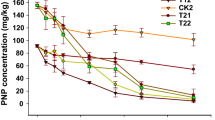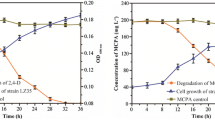Abstract
Aims
Accumulation of p-hydroxybenzonic acid (PHBA) in soil will cause plant stress. Our aims were to characterize PHBA-degrading Pseudomonas putida CSY-P1 and to assess its role on alleviating PHBA stress in plants.
Methods
Strain CSY-P1 was isolated from rhizosphere soil, and its properties were investigated. The effects of CSY-P1 on soil enzymes and oxidative damage in plants were analyzed. Under PHBA-contaminated environments, antioxidant enzyme activities in CSY-P1 were assessed.
Results
Optimal conditions for degradation of PHBA by CSY-P1 were 28 °C, pH 9, and an initial PHBA concentration of 0.6 g l−1. Protocatechoic acid was a metabolite. CSY-P1 decomposed PHBA effectively in unplanted autoclaved soil. After the strain was applied to PHBA-contaminated cucumber-planted soil, activities of some soil enzymes were increased and the PHBA concentration in soil decreased. Some antioxidant enzyme activities in leaves were elevated, thus reducing malondialdehyde levels in seedlings and mitigating PHBA stress in cucumber. Catalase activity in PHBA-exposed CSY-P1 increased.
Conclusions
Pseudomonas putida CSY-P1 degrades PHBA in autoclaved soil and alleviates PHBA stress to plants by inducing some soil enzymes and antioxidant enzymes in leaves. Catalase in strain CSY-P1 contributes to its PHBA tolerance, making it a promising strain for remediation of PHBA-contaminated soil.








Similar content being viewed by others
References
Amanatidou A, Smid EJ, Bennik MHJ, Gorris LGM (2001) Antioxidative properties of Lactobacillus sake upon exposure to elevated oxygen concentrations. FEMS Microbiol Lett 203:87–94
Annadurai G, Ling LY, Lee JF (2008) Statistical optimization of medium components and growth conditions by response surface methodology to enhance phenol degradation by Pseudomonas putida. J Hazard Mater 151:171–178
Anupama VN, Amrutha PN, Chitra GS, Krishnakumar B (2008) Phosphatase activity in anaerobic bioreactors for wastewater treatment. Water Res 42:2796–2802
Bartosz G (1997) Oxidative stress in plants. Acta Physiol Plant 19:47–64
Bradford MM (1976) A rapid and sensitive method for the quantification of microgram quantities of protein utilizing the principle of protein-dye binding. Anal Biochem 72:248–259
Chen L, Yang X, Raza W, Li J, Liu Y, Qiu M, Zhang F, Shen Q (2011a) Trichoderma harzianum SQR-T037 rapidly degrades allelochemicals in rhizospheres of continuously cropped cucumbers. Appl Microbiol Biotechnol 89:1653–1663
Chen Y, Peng Y, Dai CC, Ju Q (2011b) Biodegradation of 4-hydroxybenzoic acid by Phomopsis liquidambari. Appl Soil Ecol 51:102–110
de Souza Silva CMM, de Castro VLSS, de Oliveira PR, de Holanda Nunes Maia A (2009) Influence of Pseudomonas putida AF7 inoculation on soil enzymes. Ecotoxicology 18:1182–1187
Dong R, Gu L, Guo C, Xun F, Liu J (2014) Effect of PGPR Serratia marcescens BC-3 and AMF Glomus intraradices on phytoremediation of petroleum contaminated soil. Ecotoxicology 23:674–680
Douglas LA, Bremner JM (1971) A rapid method of evaluating different compounds as inhibitors of urease activity in soils. Soil Biol Biochem 3:309–315
Doulis AG, Debian N, Kingston-Smith AH, Foyer CH (1997) Differential localization of antioxidants in maize leaves. Plant Physiol 114:1031–1037
Fairley DJ, Boyd DR, Sharma ND, Allen CCR, Morgan P, Larkin MJ (2002) Aerobic metabolism of 4-hydroxybenzoic acid in Archaea via an unusual pathway involving an intramolecular migration (NIH Shift). Appl Environ Microbiol 68:6246–6255
Foyer CH, Halliwell B (1976) The presence of glutathione and glutathione reductase in chloroplasts: a proposed role in ascorbic acid metabolism. Planta 133:21–25
Galhano V, Peixoto F, Gomes-Laranjo J (2010) Bentazon triggers the promotion of oxidative damage in the Portuguese rice field cyanobacterium Anabaena cylindrica: response of the antioxidant system. Environ Toxicol 25:517–526
Ghosh S, Sachan A, Mitra A (2005) Degradation of ferulic acid by a white rot fungus Schizophyllum commune. World J Microbiol Biotechnol 21:385–388
Grönemeyer JL, Burbano CS, Hurek T, Reinhold-Hurek B (2012) Isolation and characterization of root-associated bacteria from agricultural crops in the Kavango region of Namibia. Plant Soil 356:67–82
Heipieper HJ, Diefenbach R, Keweloh H (1992) Conversion of cis unsaturated fatty acids to trans, a possible mechanism for the protection of phenol-degrading Pseudomonas putida P8 from substrate toxicity. Appl Environ Microbiol 58:1847–1852
Hoque MA, Banu MNA, Okuma E, Amako K, Nakamura Y, Shimoishi Y, Murata Y (2007) Exogenous proline and glycinebetaine increase NaCl-induced ascorbate- glutathione cycle enzyme activities, and proline improves salt tolerance more than glycinebetaine in tobacco Bright Yellow-2 suspension-cultured cells. J Plant Physiol 164:1457–1468
Hwang SY, Lin HW, Chern RH, Lo HF, Li L (1999) Reduced susceptibility to water logging together with high-light stress is related to increases in superoxide dismutase and catalase activities in sweet potato. Plant Growth Regul 27:167–172
Inderjit, Nielsen ET (2003) Bioassays and field studies for allelopathy in terrestrial plants: progress and problems. Crit Rev Plant Sci 22:221–238
Kohler J, Caravaca F, Roldan A (2009) Effect of drought on the stability of rhizosphere soil aggregates of Lactuca sativa grown in a degraded soil inoculated with PGPR and AM fungi. Appl Soil Ecol 42:160–165
Li DM, Zhang J, Sun WJ, Li Q, Dai AH, Bai JG (2011) 5-Aminolevulinic acid pretreatment mitigates drought stress of cucumber leaves through altering antioxidant enzyme activity. Sci Hortic 130:820–828
Lim EK, Doucet CJ, Li Y, Elias L, Worrall D, Spencer SP, Ross J, Bowles DJ (2002) The activity of Arabidopsis glycosyl transferases toward salicylic acid, 4-hydroxybenzoic acid and other benzoates. J Biol Chem 277:586–592
Lin X, Xu X, Yang C, Zhao Y, Feng Z, Dong Y (2009) Activities of antioxidant enzymes in three bacteria exposed to bensulfuron-methyl. Ecotoxicol Environ Saf 72:1899–1904
Lin RY, Wang HB, Guo XK, Ye CY, He HB, Zhou Y, Lin WX (2011) Impact of applied phenolic acids on the microbes, enzymes and available nutrients in paddy soils. Allelopathy J 28:225–236
Liu ZJ, Zhang XL, Bai JG, Suo BX, Xu PL, Wang L (2009) Exogenous paraquat changes antioxidant enzyme activities and lipid peroxidation in drought-stressed cucumber leaves. Sci Hortic 121:138–143
Luster DG, Donaldson RP (1987) Orientation of electron transport activities in the membrane of intact glyoxysomes isolated from castor bean endosperm. Plant Physiol 85:796–800
Ma Y, Wang X, Wei M, Qi Y, Li T (2005) Accumulation of phenolic acids in continuously cropped cucumber soil and their effects on soil microbes and enzyme activities. Chin J Appl Ecol 16:2149–2153
Manach C, Scalbert A, Morand C, Rémésy C, Jimenez L (2004) Polyphenols: food sources and bioavailability. Am J Clin Nutr 79:727–747
Martins PF, Carvalho G, Gratao PL, Dourado MN, Pileggi M, Araujo WL, Azevedo RA (2011) Effects of the herbicides acetochlor and metolachlor on antioxidant enzymes in soil bacteria. Process Biochem 46:1186–1195
Mathew S, Abrahama TE, Sudheesh S (2007) Rapid conversion of ferulic acid to 4-vinyl guaiacol and vanillin metabolites by Debaryomyces hansenii. J Mol Catal B Enzym 44:48–52
Middelhoven WJ, Coenen A, Kraakman B, Gelpke MDS (1992) Degradation of some phenols and hydroxybenzoates by the imperfect ascomycetous yeasts Candida parapsilosis and Arxula adeninivorans: evidence for an operative gentisate pathway. Anton Leeuw 62:181–187
Muscolo A, Panuccio MR, Sidari M (2001) The effect of phenols on respiratory enzymes in seed germination respiratory enzyme activities during germination of Pinus laricio seeds treated with phenols extracted from different forest soils. Plant Growth Regul 35:31–35
Pan X, Zhang D, Chen X, Bao A, Li L (2011) Antimony accumulation, growth performance, antioxidant defense system and photosynthesis of Zea mays in response to antimony pollution in soil. Water Air Soil Pollut 215:517–523
Pereira GJG, Molina SMG, Lea PJ, Azevedo RA (2002) Activity of antioxidant enzymes in response to cadmium in Crotalaria juncea. Plant Soil 239:123–132
Ponce BL, Latorre VK, González M, Seeger M (2011) Antioxidant compounds improved PCB-degradation by Burkholderia xenovorans strain LB400. Enzym Microb Technol 49:509–516
Rahouti M, Seigle-Murandi F, Steiman R, Eriksson KE (1989) Metabolism of ferulic acid by Paecilomyces variotii and Pestalotia palmarum. Appl Environ Microbiol 55:2391–2398
Ramiro DA, Guerreiro-Filho O, Mazzafera P (2006) Phenol contents, oxidase activities, and the resistance of coffee to the leaf miner Leucoptera coffeella. J Chem Ecol 32:1977–1988
Rice EL (1979) Allelopathy - an update. Bot Rev 45:15–109
Roberge MR (1978) Methodology of enzymes determination and extraction. In: Burns RG (ed) Soil enzymes. Academic, New York, pp 341–373
Schinner F, Von Mersi W (1990) Xylanase, CM-cellulase and invertase activity in soil, an improved method. Soil Biol Biochem 22:511–515
Seal AN, Haig T, Pratley JE (2004) Evaluation of putative allelochemicals in rice root exudates for their role in the suppression of arrowhead root growth. J Chem Ecol 30:1663–1678
Smirnoff N (1993) The role of active oxygen in the response of plants to water deficit and desiccation. New Phytol 125:27–58
Stuurman N, Bras CP, Schlaman HRM, Wijfjes AHM, Bloemberg G, Spaink HP (2000) Use of green fluorescent protein color variants expressed on stable broad-host-range vectors to visualize rhizobia interacting with plants. Mol Plant-Microbe Interact 13:1163–1169
Turner JA, Rice EL (1975) Microbial decomposition of ferulic acid in soil. J Chem Ecol 1:41–58
Vyas D, Kumar S (2005) Purification and partial characterization of a low temperature responsive Mn-SOD from tea (Camellia sinensis (L.) O. Kuntze). Biochem Biophys Res Commun 329:831–838
Wang TSC, Yang TK, Chuang TT (1967) Soil phenolic acids as plant growth inhibitors. Soil Sci 103:239–246
Wang LL, Wang ET, Liu J, Li Y, Chen WX (2006) Endophytic occupation of root nodules and roots of Melilotus dentatus by Agrobacterium tumefaciens. Microb Ecol 52:436–443
Wang GL, Wang L, Chen HH, Shen B, Li SP, Jiang JD (2011) Lysobacter ruishenii sp. nov., a chlorothalonil-degrading bacterium isolated from a long-term chlorothalonil-contaminated soil in China. Int J Syst Evol Microbiol 61:674–679
Wang H, Xu R, You L, Zhong G (2013) Characterization of Cu-tolerant bacteria and definition of their role in promotion of growth, Cu accumulation and reduction of Cu toxicity in Triticum aestivum L. Ecotoxicol Environ Saf 94:1–7
Weir TL, Park SW, Vivanco JM (2004) Biochemical and physiological mechanisms mediated by allelochemicals. Curr Opin Plant Biol 7:472–479
Xie MH, Ren Q, Zhang QW, Liu XX (2010) Composition of phenolic allelochemicals in Eupatorium adenophorum root zone soils and its effects on soil-borne pathogens. Chin J Appl Ecol 21:306–311
Xu PL, Guo YK, Bai JG, Shang L, Wang XJ (2008) Effects of long-term chilling on ultrastructure and antioxidant activity in leaves of two cucumber cultivars under low light. Physiol Plant 132:467–478
Zhang Y, Gu M, Shi K, Zhou YH, Yu JQ (2010a) Effects of aqueous root extracts and hydrophobic root exudates of cucumber (Cucumis sativus L.) on nuclei DNA content and expression of cell cycle-related genes in cucumber radicles. Plant Soil 327:455–463
Zhang ZY, Pan LP, Li HH (2010b) Isolation, identification and characterization of soil microbes which degrade phenolic allelochemicals. J Appl Microbiol 108:1839–1849
Zhang J, Li DM, Sun WJ, Wang XJ, Bai JG (2012a) Exogenous p-hydroxybenzoic acid regulates antioxidant enzyme activity and mitigates heat stress of cucumber leaves. Sci Hortic 148:235–245
Zhang Y, Meng D, Wang Z, Guo H, Wang Y, Wang X, Dong X (2012b) Oxidative stress response in atrazine-degrading bacteria exposed to atrazine. J Hazard Mater 229–230:434–438
Zhu Z, Wei G, Li J, Qian Q, Yu J (2004) Silicon alleviates salt stress and increases antioxidant enzymes activity in leaves of salt-stressed cucumber (Cucumis sativus L.). Plant Sci 167:527–533
Acknowledgments
We thank Dr. Susheng Yang (China Agricultural University, China), Dr. Binghai Du and Dr. Yanqin Ding (Shandong Agricultural University, China) for providing the Escherichia coli S17-1 strain with the pMP2444 shuttle vector.
Author information
Authors and Affiliations
Corresponding author
Additional information
Responsible Editor: Sven Marhan.
Shu-Yun Chen, Li-Yuan Guo and Ji-Gang Bai are contributed equally to this work.
Rights and permissions
About this article
Cite this article
Chen, SY., Guo, LY., Bai, JG. et al. Biodegradation of p-hydroxybenzoic acid in soil by Pseudomonas putida CSY-P1 isolated from cucumber rhizosphere soil. Plant Soil 389, 197–210 (2015). https://doi.org/10.1007/s11104-014-2360-x
Received:
Accepted:
Published:
Issue Date:
DOI: https://doi.org/10.1007/s11104-014-2360-x




